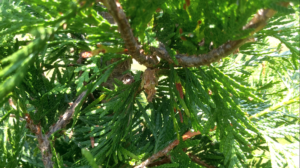
You can treat bagworm damage by first identifying the bagworm. See one here hanging from a branch.
The Thyridopteryx ephemeraeformis, otherwise known as a bagworm, is a moth caterpillar that hatches its eggs in early June and constructs a home, or “bag,” from its silk and the leaves and stems from its host plant. Because a bagworm is often easy to mistake for being part of the tree on which it feeds, it can often go uncontrolled as it continues to feed on its host. A bagworm will feed on many types of landscape plants, but are especially damaging to evergreens. Timely and proactive treatment is required to save plants from these pests, so if you suspect your trees are suffering from a bagworm infestation read on to learn the signs. Once you spot a bagworm, you can begin to treat the problem.
The Signs of Bagworm Damage
If you notice sudden, dramatic changes in your evergreens, this can signal bagworm damage. This can mean that your tree becomes sickly, pale, and near-death in just a matter of weeks during the summer. Trees and shrubs will turn brown and drop needles or leaves, but irrigation and fertilizer won’t help. You should then look for the bagworm itself.
How to Spot a Bagworm
From hatching in June to the end of its feeding season in mid to late-August, a bagworm will live inside its “bag” as it consumes its tree host. As you can see in the video below, the bag often looks similar to a small pine cone, about one to two inches long. The bag may move back and forth as worms stick their heads and legs out. After finishing their feeding for the summer, and causing severe damage and defoliation, the pest will begin laying eggs that will hatch next spring. It is crucial that you control your bagworm infestation before they can lay their eggs. A bagworm may lay as many as 1000 to 1500 eggs.
How to Treat Bagworm Damage
The best option to control bagworm populations and prevent future damage is to use insecticides effective on bagworms and their larvae. This treatment is most effective in June when the worms are first emerging, but you can continue to apply through July and August if they are still feeding. If you notice any bags in the winter, you can pick those off and destroy them, but if you miss even one bag, this may result in as many as 500 eggs hatching in the spring.
If your plant is weakened by bagworm damage, it should be fertilized to stimulate new growth. Any limbs or plants that have been denuded and fail to refoliate in the spring should be removed.
Scientific Plant Service Is Your Go-To Source In Landscape Healthcare
Scientific Plant Service, located in Baltimore, is a privately owned corporation, chartered in Maryland in 1957 by Frank J. Burke. We started as a full-service Arborists specializing in the care of shade trees and ornamental shrubs, but today we are a Lawn Care company that is a huge part of the community. From aquatic environments and snow management to deer and mole control, SPS has services tailored specifically for your lawn and landscape.
We offer services in Maryland, Washington, DC, and Virginia, including: Harford, Baltimore, Carroll, Frederick, Howard, Anne Arundel, Montgomery, Prince Georges, Talbot, Queen Anne’s, Calvert counties in MD, as well as Loudoun County, Fairfax County, Arlington, Alexandria, and Falls Church in VA. For more information, contact us online, or call us at 410-321-0970. Be sure to follow us on Facebook, Twitter, LinkedIn, and Pinterest!

